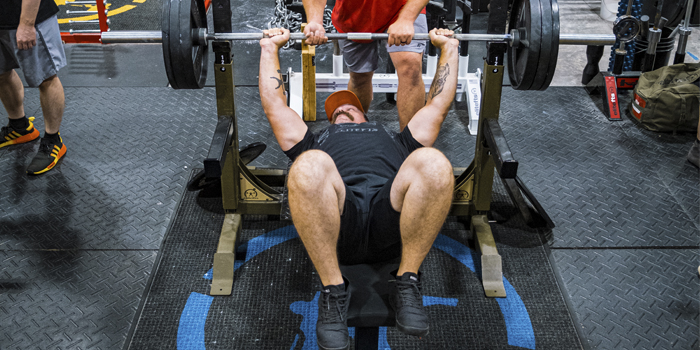
At Southeast Missouri State University, our strength and conditioning department implements a block-style training system with most of our athletic teams. By far one of the most impressive means we have implemented within our system has been something called tri-phasic periodization. Cal Dietz (Director of Strength and Conditioning at the University of Minnesota) discussed the implementation of such a system during the University of Richmond Strength and Conditioning Clinic this past April. After speaking with Cal about how he implements it, we put our own twist on the system and have been nothing less than shocked with the results.
So, what exactly is tri-phasic periodization? Tri-phasic periodization breaks up a training block into three segments; a Two-week eccentric block, Two Two-week isometric block, a Two-week concentric block, and after completing the full six weeks a one to two week de-load is absolutely necessary. While implementing this program we have given our athletes complete rest during this de-load. Although they are allowed to do any type of
training as long as they do not touch a barbell for bench, squat, or deadlift, yet most choose to do nothing.
Exercise Selection
As far as exercise selection goes, there are a few routes you can take. You can either utilize this method for primary lifts (squat, bench) or for accessory lifts (walking lunges, single leg squats, glute ham raises, pull-ups). At Southeast, I have used both models. During the off-season period, primary lifts seem to work better, and during our in-season period, the accessory path works EXTREMELY well. I would also suggest this path for those who are looking for a challenge but are beat up and do not feel like putting a bar on the back.
For our tri-phasic blocks, we have implemented this system to develop two entirely different attributes, maximal strength or speed/power. Currently, our football players are implementing the speed-oriented block during our spring ball season. I have listed our loading scheme below for either approach.
Maximal Strength
Week One | 80% (ECCENTRIC) 3x3 w/ 6 second eccentric | 92% (NORMAL LOADING) 3x1 | 70% (ECCENTRIC) 3x4 w/ 6 second eccentric |
Week Two | 85% (ECCENTRIC) 3x3 w/ 6 sec. ECC | 3x1 (BEAT LAST WEEK’s BEST) | 75% (ECCENTRIC) 3x4 w/ 6 second eccentric |
Week Three | 80% (ISOMETRIC) 3x3 w/ 3 sec. ISO base this off of last Wednesday’s Best | 3x1 @ 92-95% (normal loading) based off of last Wednesday’s best | 70% (ISOMETRIC) 3x4 of WK 2’s Best Squat |
Week Four | 85% (ISOMETRIC – Box Squat) 3x3 based off of WK 2’S BEST | 3x1 (BEAT LAST WEEK’s BEST) | 75% (ISOMETRIC – Box Squat) 3x4 w/ WK 2’s Best |
Week Five | 80% (move bar as fast as possible) 3x3 based off of Wk 4’s Best | 3x1 @ 92-97% of WK 4’s Best | 70% (move bar as fast as possible) 3x4 based off of Wk 4’s Best |
Week Six | 85% (move bar as fast as possible) 3x3 based off of WK 4’s Best | 3x1 (WORK UP TO NEW MAX) | 75% (move bar as fast as possible) 3x4 of WK 4’s Best. |
Results
Under the maximal strength template, we used three of our football players during the peak of our summer conditioning program this past year, and on average they gained 70 pounds on their maximal squat over this period. Keep in mind we were running five days per week and squatting three days per week and still experienced these results! When planning your accessory lifts during this time, stick to three total lifts a day. So squat, lunge/step-up, and low back/hamstring movement or abs. Keep it simple!
Here are some videos to give you a reference to how these exercises are executed. For the eccentric phases, we use a six-second lowering count with the spotter helping the lifter back up to the top of the lift, and with the isometric phases, we use a three-second count at the bottom of the lift.
Eccentric Squat
YouTube
Pause Squat
YouTube
As for a speed/power block, the percentages would stay relatively the same throughout the block. Again we still follow a Two-week min-block for eccentric, isometric, and concentric phases.
Speed
| Week One | 70% (ECCENTRIC) 3x3 5x1 (up to 80%) 55% (ECCENTRIC) 3x4 |
| Week Two | 75% (ECCENTRIC) 3x3 5x1 (up to 85%) 60% (ECCENTRIC) 3x4 |
| Week Three | 70% (ISOMETRIC) 3x3 5x1 (up to 80%) 55% (ISOMETRIC) 3x4 |
| Week Four | 75% (ISOMETRIC) 3x3 5x1 (up to 85%) 60% (ISOMETRIC) 3x4 |
| Week Five | 70% (DYNAMIC) 3x3 5x1 (up to 80%) 55% (DYNAMIC) 3x4 ADD CHAINS |
| Week Six | 75% (DYNAMIC) 3x3 5x1 (up to 85%) 60% (DYNAMIC) 3x4 ADD CHAINS |
Now some of you may be thinking, “What about upper body training?” or “I do not feel like squatting three times per week”. There are multiple ways to implement this schedule. But if you do not like any of my templates, find your own. These are just what have worked for us.
Five Days/Week
| Monday | Tuesday | Wednesday | Thursday | Friday |
| Day 1 Lower | Upper Body Max Effort | Day 2 Lower | Upper Body Dynamic Effort | Day 3 Lower Rep Effort Upper |
Four Days/Week
| Monday | Tuesday | Thursday | Friday |
| Day 1 Lower | Upper Body Max Effort | Day 2 Lower | Upper Body Rep Effort or Dynamic Effort |
Three Days/Week
| Monday | Wednesday | Friday |
| Day 1 Lower + Max Effort Upper | Day 2 Lower + Dynamic Effort Upper | Day 3 Lower + Rep Effort Upper |
French Contrast
For those of you who are up for a MAJOR challenge, I suggest mixing tri-phasic blocks with plyometrics. This is what is referred to as French Contrast. French Contrast was the brainchild of French sport-scientist Gilles Cometti. Contrast refers to alternating between slow-speed sets and high-speed sets. So, by implementing strength training along with the plyometrics we experience positive changes in both maximal strength and speed. As the saying goes, to be fast you must train fast. When selecting exercises for the French Contrast, try to look at the joint angles that will be encountered during the game to make this as specific as possible for our athletes. A simple grouping of jumps would be hurdle hops,
dumbbell squat jumps, and split squat jumps. Between the sets of squats and each of the jumps, give yourself at least 20 seconds of rest. You want to be able to give each of the exercises the highest quality possible.
This would look like:
1. Squat Warm-up Sets – Whatever you need to do
2a. Squat (whatever mini-block you are in for the tri-phasic period)
2b. Hurdle Hops (over Four hurdles quickly, but stick the last landing)
2c. DB Squat Jumps – x Six (20-35#)
2d. Split Squat Jumps – x Six total reps
Rest for three to five minutes, and repeat for three sets
OR for those of you who need a visual example like me:
French Contrast
YouTube
I hope that this article has given you some ideas on how you can improve both your strength and power. So if you are up for six weeks of the most grueling training you can imagine only to have your performance shoot through the roof, give tri-phasic periodization a rip. You won’t be disappointed.
References
- Cometti, G. Endurance de Force ou Force d’Endurance.
- Dietz, C. (2010, May). Programming Model of Tri-Phasic Exercise Sequencing Model, University of Richmond Strength and Conditioning Conference.
- Siff, M.C. (2000). Supertraining. (Fifth edition). Denver, Colorado.
- Thibaudeau, C. Theory and Application of Modern Strength and Power Methods.
On September 1, 2008, Southeast Missouri State announced the hiring of Jeff Lee as their new strength and conditioning coach for all 15 varsity sports. His duties include overseeing the design and implementation of the strength training and conditioning programs.
Before his hiring, Lee served in the same capacity at Canisius College.
Lee joined the Canisius College staff after serving a two-year stint as the assistant strength and conditioning coach at Yale University. There, he worked with 11 of the Bulldogs' varsity teams and served as the primary strength and conditioning coach for the men's and women's ice hockey teams. He was responsible for designing and implementing speed, strength, and conditioning programs for the hockey teams.
Lee also spent time as an assistant at The Citadel in Charleston, S.C. before Yale. He worked primarily with the school's men's basketball program as he earned his master's degree in exercise science. He also worked at the United States Olympic Education Center in Marquette, Michigan, where he developed and implemented strength training programs for 23 elite amateur boxers.
Lee received his undergraduate degree in physical education from Western Illinois in 2003. A member of the National Strength and Conditioning Association and the Collegiate Strength and Conditioning Coaches Association, he started his career as an intern at Binghamton University in August 2003.












You mention in wk 3 “92-97% based on last weeks best”, which poses a couple questions. If in wk 2 you are only trying to beat the 92% weight from wk 1, won’t using whatever resistance you reach (likely between 93-97%) in the end lower the reference RM for wk3? From my understanding, the only way to not lower the reference RM for subsequent weeks is to beat your 1 rep max in wk2 and wk4.
OR is the intention to lower the weights slightly for each block, since we’re focusing on different movement phases, which requires lower percentages of the reference RM.
Appreciate the input.